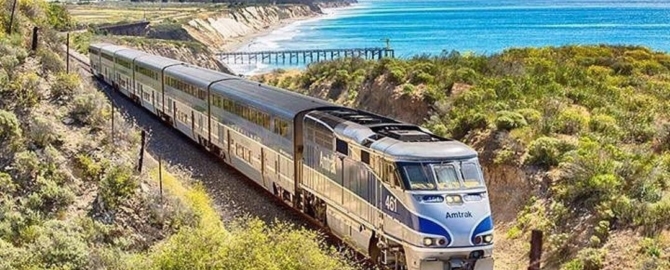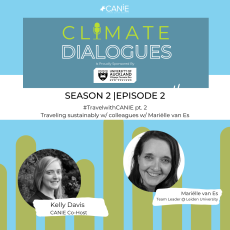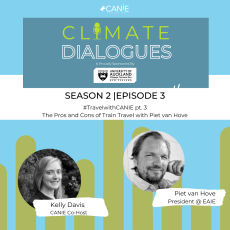Why join #TravelWithCANIE?

Reduce your emissions by 90% from Los Angeles to San Diego
✈️ Flying = 96 kg CO₂
🚘 Driving = 48.4 kg CO₂
🚆 Train = 8.8 kg CO₂
Choosing the train significantly reduces your carbon footprint compared to both flying and driving the same route. Short flights, like LAX to SAN, have a disproportionately high environmental impact due to the fuel-intensive takeoff and landing phases. These phases contribute more heavily to the overall emissions of short flights than longer ones, resulting in higher CO₂ emissions per passenger per mile/kilometer, all that plus:
- Scenic Coastal Views: Enjoy a ride with the most scenic views of Southern California, starting in LA and gliding through Long Beach, Orange County, past San Clemente's beaches, Oceanside, Solana Beach, and the Del Mar bluffs, before arriving in San Diego.
- Comfort, Productivity and Networking: Skip the airport hassle and use your travel time to relax, work, and network with fellow attendees.
- Stress-Free and budget-friendly trip: You likely have a direct flight to LAX, but probably not to San Diego. Avoid extra flight connections, re-checking baggage and airport security lines. Also, Flights to Los Angeles are often more affordable than connecting flights to San Diego due to the greater number of airlines and flight options available.
Travel Details
Route: Los Angeles (Union Station) → San Diego (Santa Fe Depot)
Travel Time: 2 hours 54 minutes
Frequency: 10 trains/day from 6 AM to 10 PM
Tickets: One Way → USD 36 (Coach) USD 55 (Business)
⚠️ IMPORTANT NOTICE: Travel disruptions due to emergency works are affecting the train ride from Los Angeles to San Diego
Check more information here
Getting to and from the train stations
LAX to LA Union Station
- FlyAway® Bus:
Departs every 30 minutes (5:40 AM - 1:10 AM) - Approx. 45-minute ride.
Departs from Lower/Arrivals Level, find the blue FlyAway signs.
Fare: $12.75 (contactless Visa/Mastercard, Apple Pay accepted on board).
More details here - Ride-Share/Taxi (Uber/Taxi):
17 miles, approx. 30-50 minutes. Estimated fare: $40-$60
San Diego's Santa Fe Depot to your hotel
Conveniently located a short walk or tram ride to hotels and the Convention Center.
Click here to check the exact location and calculate your walking distance on Google Maps

Steps to join the #TravelwithCANIE movement:
1 – Fill out the form
Let us know your travel details and commitment to a low-carbon journey to #NAFSA2025. We’ll calculate the total CO₂ savings made by our community.
2 – Book your train!
3 – Find travel companions
Join our LinkedIn Group to connect with others on the same route, meet new colleagues, and make the most of your travel time by networking.
4 – Share your experience
Show your commitment to greener travel! Share photos and videos on social media using #TravelWithCANIE to inspire others.
5 – Collect your “I Traveled Green” Ribbon!
At the conference, stop by the NAFSA Pavillion to pick up your pin, add it to your badge, and spread the word about your sustainable travel choice.
An award-winning initiative

Perks of Participation
Following the conference, we will provide participants of the #TravelWithCANIE initiative with a certificate outlining their contribution in reducing emissions to the total emissions reduction achieved as part of the conference. Share and encourage your colleagues to #TravelWithCANIE for their next event!
Every person who commits to reducing the CO2 emitted helps us get closer to the target. Help us reduce the emissions, one tonne at a time!
About the Pacific Surfliner
The Pacific Surfliner is a 351-mile scenic Amtrak passenger train service that connects the coastal communities of Southern California, running between San Diego and San Luis Obispo. As Amtrak's third-busiest route nationwide, and its most popular outside the Northeast Corridor, it serves nearly 3 million passengers annually.
The Pacific Surfliner's roots trace back to 1938 with the "San Diegan" service uniting Los Angeles and San Diego. It was renamed the Pacific Surfliner in 2000 to better reflect its coastal route.
Launched by the Atchison, Topeka and Santa Fe Railway, the San Diegan was more than just a train; it was a symbol of streamlined elegance and efficient travel in Southern California. Imagine sleek, stainless steel cars gliding along the coast, offering passengers a comfortable and scenic ride.
The San Diegan operated for over six decades, carrying countless passengers and becoming a beloved part of Southern California's transportation history.
Today, the Pacific Surfliner symbolizes Southern California's unique charm and the enduring appeal of train travel. It's more than just transportation; it's an experience—a chance to slow down, appreciate the coastal beauty, create lasting memories, and reduce your carbon footprint.

Sustainability Initiatives on the Pacific Surfliner:
-
Renewable Diesel: In late 2023, the Pacific Surfliner fleet transitioned to renewable diesel. This fuel, made from sustainable sources like used cooking oil, significantly reduces greenhouse gas emissions (by an estimated 63%) compared to traditional diesel, a major step in lowering the train's carbon footprint.
-
Energy Efficiency: Train travel is inherently more energy-efficient than driving. The Pacific Surfliner enhances this with its modern Siemens Charger locomotives, which are not only fuel-efficient but also boast cleaner emissions, contributing to better air quality.
-
Onboard Sustainability: The Pacific Surfliner is focused on reducing waste and promoting sustainable practices onboard, including recycling options and increasing the availability of locally sourced and plant-based food options in its cafe cars.
-
Car-Free Travel: The train encourages car-free exploration of Southern California. Conveniently located near attractions, many stations facilitate getting around without a car, reducing reliance on personal vehicles and promoting sustainable tourism.
How to calculate your emissions
Now that you have committed to being part of the #TravelwithCANIE initiative, are you curious to know how much CO2 have you helped save by making a sustainable travel choice?
Follow the instructions on this CO2 calculator to find out!
Travel and Climate's Emissions Calculator
Interested in learning more about Carbon emission calculators and which ones we should be using in International Education? Read this great article from Professor Stephen Robinson to learn more.




